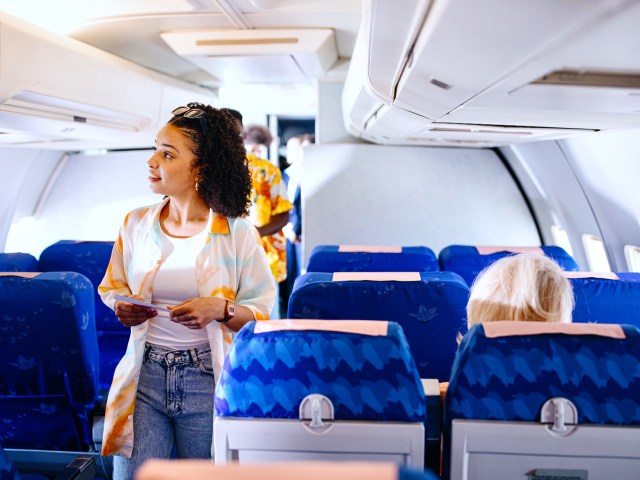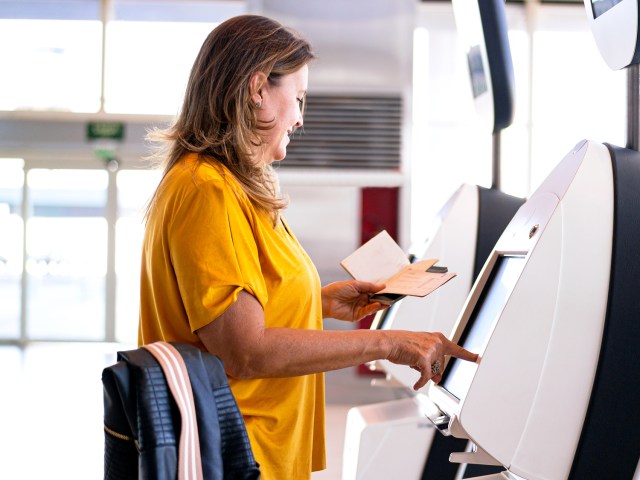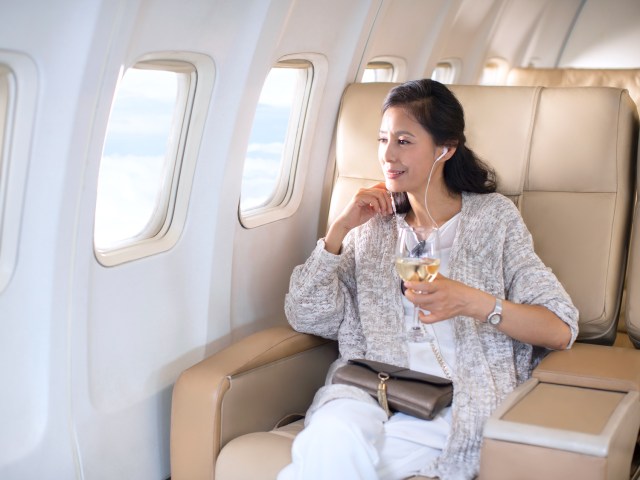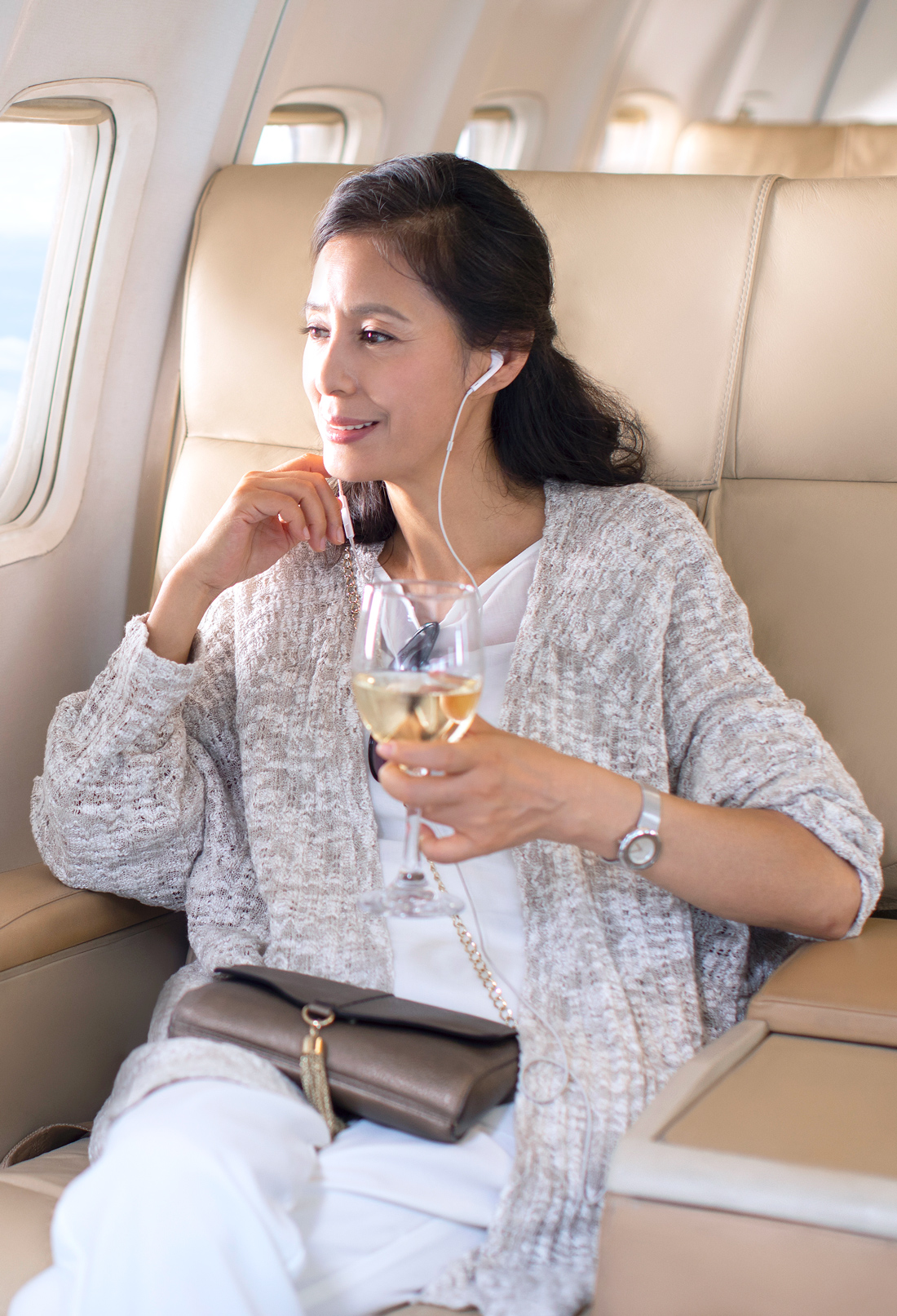When flying, most travelers do everything possible to avoid being stuck in a middle seat, especially one way at the back of the plane. But otherwise, you may think that most economy-class seats these days are more or less the same (read: cramped). That’s not necessarily true, however. Even if you don’t have the budget to splurge on first or business class — though it may actually be cheaper than you think — economy-class seats are far from equal when it comes to comfort. Follow these helpful tips and tricks to score a better airplane seat.
Know the Ins and Outs of the Seat Map

The first step to scoring a better seat: researching the seat map. When choosing a seat during the booking process, travelers will be able to tell which seats are window versus middle versus aisle, and which seats are located toward the front or back of the plane. But there are several other important details to be aware of — you just might have to do a little more digging.
Most airlines have a dedicated section on their website with more detailed aircraft seating plans that include helpful information such as seat pitch (the distance between rows of seats) and seat width, plus which seats are located at emergency exits or bulkheads (these seats have a fixed wall directly in front, typically providing more leg space, but nowhere to store a bag under the seat in front). Airline seat maps will also mark specific seats that have limited recline (usually those right in front of an exit row) or more limited width due to their location in the cabin. If the airline’s website doesn’t show these details, it’s a good idea to also consult websites such as AeroLOPA, which compile seat maps across carriers.
When reviewing the seat map, you’ll also get a good sense of what the average legroom is — remember, some airlines are more generous than others — and be able to spot which seats have advantageous locations. For example, some rows might be missing a seat in front or be arranged in a two-by-two configuration instead of the typical three-by-three layout, which can be better for couples.
Check In Early

You probably already settled on a seat during the booking process, but it’s still worth checking in as soon as the airline allows to see if your options have changed. In the days and hours leading up to departure, airlines process upgrades for frequent flyers, which will often open up better seats for selection. By checking in early, you can beat your fellow travelers to the punch. Additionally, for travelers who don’t have status, some seats can show as unavailable during the booking process, but might become available to all flyers once check-in opens.
Even if you don’t score a better seat when check-in opens, it’s worth keeping an eye on the seat map up until departure. You can do so by managing your booking on the airline’s website or app — some airline apps make it easy to view seat maps when checking your flight status. If you see your preferred seat open up, you should be able to change it in the app before boarding begins.
You might not even have to put in the legwork, however. In early 2024, United Airlines introduced a useful new feature within its app that will send a push notification to flyers, alerting them if their preferred seat has become available. Another useful tool is the ExpertFlyer website, where subscribers can set up similar seat alerts.
Be Strategic

Ever sat next to an empty seat during the boarding process, counting down the minutes until flight attendants close the boarding door in hopes that it remains open? Scoring some extra elbow room next to an unoccupied seat is one of the best free perks of traveling, but with record load factors these days, it’s far from guaranteed. That said, a little strategy can go a long way.
First, consider traveling at off-peak times. Some days of the week — usually Tuesdays, Wednesdays, and Saturdays — typically see far fewer business travelers, which means planes will be less full. If you’re traveling to a popular destination, try visiting during quieter months, such as when schools are back in session, for the best chance of scoring some extra room to spread out.
Second, carefully consider the location of your seat. According to travel expert Zach Griff at The Points Guy, the seats toward the front of the cabin tend to fill up first, leaving more empty seats toward the back. Some airlines even charge extra for “preferred” seats at the front of the cabin, as travelers are often willing to pay more to be off the plane sooner. So, it might be worth settling on a seat toward the back for greater odds of having no one next to you. (It might also be the safest section of the airplane.)
Two travelers flying together can also consider a hack on aircraft with seats arranged three-by-three across the aisle — the typical arrangement on most narrowbody aircraft these days. Instead of booking a window and a middle (or an aisle and a middle), try booking the aisle and the window, leaving the middle seat open. The rationale is that travelers will only choose that middle seat if there are no better options available, resulting in a higher likelihood of it remaining open. (If that’s not the case, the couple should be prepared to have a stranger sitting between them; however, the person who ends up in the middle seat will often be happy to switch to an aisle or middle.)
Take Advantage of Affordable Upgrades

While first- or business-class upgrades can be expensive, many airlines offer extra-legroom seats in economy class that are more affordable. These extra-legroom economy seats go by different names — Economy Plus on United Airlines, Comfort+ on Delta, and Main Cabin Extra on American, for example — and they can be an attractive option for passengers looking for added comfort without breaking the bank.
A few airlines have also introduced options with more elbow room, too. Budget carrier Frontier Airlines calls this upgraded seating option “UpFront Plus,” and it includes a seat in the first few rows of the cabin with extra legroom and a guaranteed free middle seat next to you, with pricing starting at $49 per segment, as of 2024. Spirit Airlines has a similar option called “Go Comfy,” while Australian flag carrier Qantas offers “Neighbour Free” seating.
More from our network
Daily Passport is part of Inbox Studio, which publishes content that uplifts, informs, and inspires.























